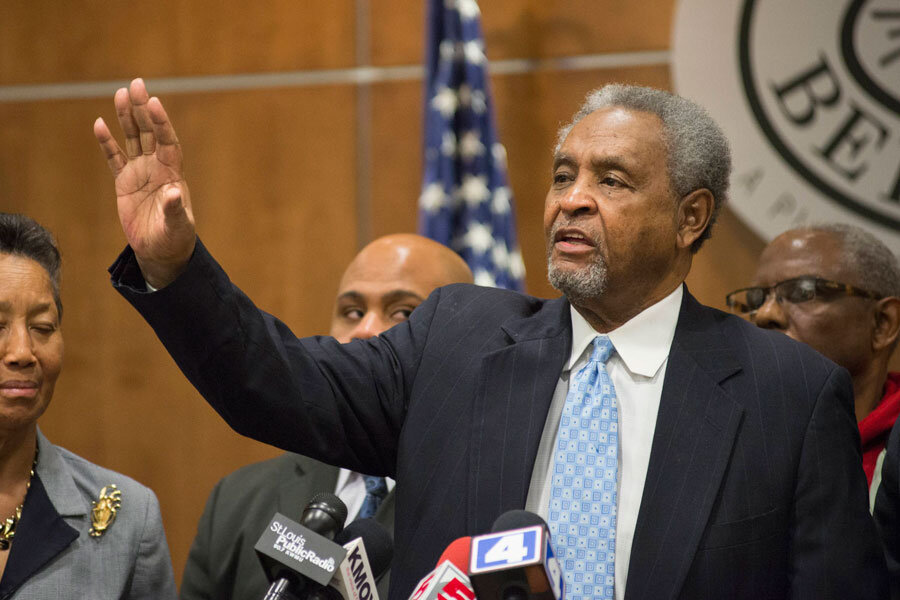Police kill black teen near Ferguson, but similarities appear to end there
Loading...
Across the country in recent months, from Houston to Milwaukee and Cleveland, fatal police shootings of black Americans have captured public attention. But the one in Berkeley, Mo., Tuesday night, just a few miles from Ferguson, appears different.
The officer said 18-year-old Antonio Martin was pointing a gun at him. Video cameras at the gas station where the shooting happened appear to show the gun. A gun was recovered as evidence. Moreover, the police force in Berkeley is majority black, and the mayor of Berkeley, who is black, said of the incident:
“This was not the same as Ferguson…. Everybody don't die the same.”
Yet the frayed trust and lingering tension in the St. Louis area led protesters to converge on the gas station where Mr. Martin had been shot, and police struggled at times to control violence in the crowd early Wednesday.
In the wake of Michael Brown’s death in Ferguson, every police shooting is getting heightened media attention. Protests in Ferguson and New York have also kept the issue in the public spotlight. One consequence is that the confluence of multiple cases is opening a more nuanced and multifaceted window – rarely glimpsed by many Americans – onto how police handle high-risk interactions.
- In Cleveland, two officers were involved in the fatal shooting of 12-year-old Tamir Rice on Nov. 22. They say they told him to raise his hands three times, but when he instead reached for a gun in his waistband, they shot him. The gun was a toy. A resident had told the 911 dispatcher that the gun was “probably fake,” but this was not relayed to the officers. A grand jury has not yet decided whether the officers will face charges.
- In Milwaukee, an officer was called to investigate a call about a black man asleep in a park in April. When the officer began to pat down the man, a fight ensued, with the man eventually taking the officer’s baton and striking him with it. The officer then shot the man 14 times. The officer will not face charges, though he lost his job.
- In Houston, an off-duty officer working as a strip-mall security guard confronted a black man he thought might be the suspect in a string of robberies. A struggle ensued before, according to the officer, the man put his hand in his waistband and charged. The officer shot. The man was unarmed. The officer will not face charges.
This follows on the cases of Michael Brown in Ferguson and Eric Garner in New York’s Staten Island borough – unarmed black men killed by police. In the Ferguson case, police say Mr. Brown was charging the officer, though eyewitness accounts vary. In the Staten Island case, police say Mr. Garner was resisting arrest, though videos have raised questions about whether the "chokehold" that led to Garner’s death was necessary. Both officers will not face charges.
For some Americans, a seeming pile-up of police shootings – and a failure of the justice system to bring charges against officers responsible – points to a law enforcement system stacked heavily and harshly against blacks. Others rally firmly to the side of the police. The fatalities have often involved people who were resisting authority.
But even as opinions vary about the events, they point to the dangers police face on their beats and the broad support they have in their mission to protect the public.
The FBI warned, for example, that police departments around the country could be targets of violence in the wake of a Missouri grand jury’s decision about the police officer who shot Michael Brown. And last week, two New York City police officers were shot dead, allegedly by a man who had used social media to threaten anti-police violence in retribution for the deaths of Brown and Eric Garner.
The slaying of the New York officers has elicited public support for police, even as many in the city say the officer in Garner's death should have been indicted.
Philadelphia Mayor Michael Nutter summed up the challenge this way in a Dec. 7 NBC interview: “You, in essence, have the citizens who want to be protected who are now increasingly afraid of the police. And you have some police officers who are increasingly afraid of the community.”
He said “there is a large gap,” and that a key part of the solution is better training police to bridge it.
President Obama has called for more money to help with police training and deploying body cameras to record police-public interactions. Mr. Obama has also set up a task force on 21st century policing, chaired by Philadelphia Police Commissioner Charles Ramsey. And the Justice Department has been investigating cases of potential civil rights violations by police departments.








